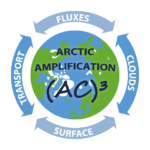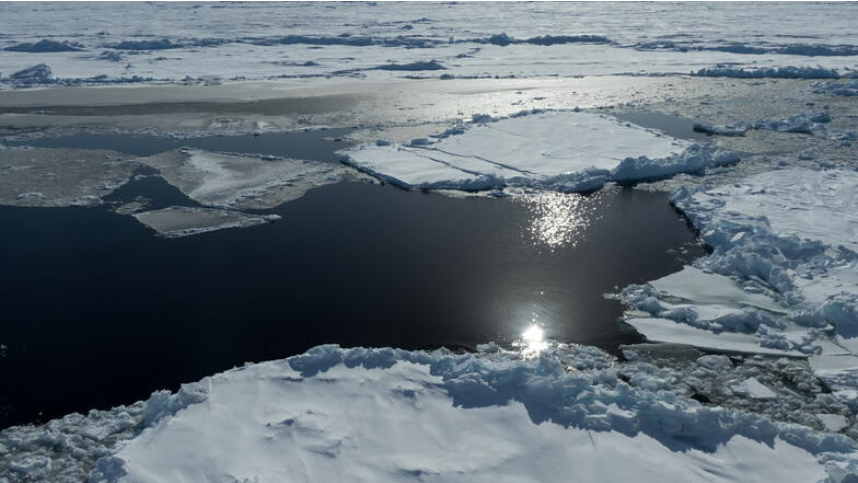27 October 2022
Kampagnenfilm und weiteres Material jetzt online / Campaign film (in German) and further material now online
DLR-Filmarchiv: Footage HALO-(AC)³ Kiruna http://filmarchivvopr.dlr.de/de/content/footage-halo-ac3-kiruna
bei Fragen zum Footage bitte wenden an / for questions about the footage please contact: presse@dlr.de
June/July 2022
First HALO-(AC)³ Science Workshop in Hamburg, 14 – 15 July 2022
Scientific talks or posters covering HALO-(AC)³ topics like warm air intrusions and atmospheric rivers, collocated remote sensing and in-situ observations, cold air outbreaks, air mass tracking and atmospheric dynamics, polar low, cirrus over/and sea ice or observations at Ny-Alesund as well as further HALO-(AC)³ related topics will be presented.
Please contact Anja.Schwarz@uni-leipzig.de for more information.
05 May 2022
Perfektes Wetter für den #Beluga-Fesselballon in #Nyålesund auf #Svalbard... TNX to @_DunkleWolke ! --- #AC3TR @dfg_public zu #Wolken & #Klimawandel in der #Arktis mit @TROPOS_de @RSAtmos_LIM @UniLeipzig & @AWI_de https://t.co/OXREzyWobl
— TROPOS (@TROPOS_de) May 5, 2022
28 April 2022
G. Apollonio from RaiDue report in Tg2Rai on the BELUGA measurements at AWIPEV in Ny Alesund, Svalbard (ca. 26:14-27:42 min):

22 April 2022
Bericht in der Sächsischen Zeitung zum Abschluss der Messkampagne HALO-(AC)³:
@saechsischeDE report on our successful #HALOAC3 campaign 😊 https://t.co/GO3eyzwcef
— HALO-(AC)³ (@HALOAC3) April 22, 2022


14 April 2022
HALO-(AC)³ concluded, HALO is back home
With the return of HALO back to Germany we conclude an extraordinarily successful research campaign. About 80 international scientists and technicians have put in a great effort to make this happen. Thank you!
We conducted 17 scientific flights, performing more than 150 flight hours. Thereby, more than 110.000 km were flown. We launched 347 dropsondes!
Being back home we are exhausted but also very grateful for the amazing time we spent in the Arctic. And, of course, we are eager to have a deeper look into the data obtained.


13 April 2022
Both Polar Aircraft Heading Home
Today, both Polar aircraft of AWI head back home to Bremen. In the past four weeks, Polar 5 completed 88 flight hours covering 14.000 km. Polar 6 even surpassed this with 100 flight hours and flight tracks totaling to 23.000 km. An incredible wealth of data has been obtained which will help us for a better understanding of Earth’s warming climate and even weather patterns in the mid-latitudes.
Why measurements in the Arctic are particularly valuable for this aim, but challenging as well, explains Andreas Herber from AWI: “The Arctic is one of the most sensitive regions on Earth. Environmental and climate changes have an even greater impact there, than in the mid-latitudes. For example, a global temperature increase of 1.5 °C, means a much higher temperature increase for the Arctic, which is proven by the measurements of the last years. Weather patterns in Europe and North America are decisively determined by atmospheric processes occurring in the Arctic. Although our knowledge has improved in recent decades, many questions remain unanswered. This is partly due to logistical difficulties for any measurements in the Arctic, but also to the limitations under which aircraft measurements can be made. The Arctic Ocean is surrounded by continents where the number of airports near the coast is limited. In addition, the regions bordering the ocean are divided into territories of different countries. Although there is coordination through the „Arctic Council“, measurement missions over the entire Arctic are difficult to carry out.”


13 April 2022

After a few days at the beginning of the campaign with two snow storms and a lot of snow shoveling – the winch for the ballon was completely buried in snow – we could finally get started. With best sunshine but at least in the beginning still with decent wind we started – unfortunately without clouds. A highlight were measurement flights under “Arctic Haze” conditions, where the aerosol number concentration was an order of magnitude higher than on other days and you could see the aerosol layer with the naked eye. Also in the second half the sometimes unpredictable and hard to predict wind caused many “flight cancellations”, but in the end it became much better and only the currently many passenger flights sometimes prevented us from a good balloon ascent or we had to become very flexible to be able to perform ascents undisturbed.
That this season would be challenging and complicated was clear from the start, but we were able to make some interesting measurements and now hand over the field to the second group that will fly to Ny Alesund after Easter and continue the measurements until mid-May – hopefully with some reachable clouds and interesting conditions.
Text: Holger Siebert
13 April 2022
10 April 2022
Today's action: Last combined and colocated flight of all 3 aircraft during #HALOAC3. #HALO will sample the warm moist air south of #Svalbard, while later it will join #Polar5 & #Polar6 west of #Svalbard. It's great to have all 3 together in the #Arctic.
— HALO-(AC)³ (@HALOAC3) April 10, 2022
(📸DLR & H.Müller) pic.twitter.com/vJX0DYfsyj

08 April 2022
The tethered balloon BELUGA has been used on 7 days since mid-March 2022 and has completed a total of 15 flights up to now. Before the measurement, it is prepared in the port warehouse (see photo below left) and then transported by snowmobile (see photo in the center below) through the village to the container, from where the measurements start. The container is located near the AWIPEV observatory (see photo below right). There, the instruments are attached to BELUGA and the balloon ascent can begin. Here you can find detailed information on the measured quantities.



07 April 2022
Janosch Michaelis von AWIs4Future berichtete live aus Spitzbergen von der Messkampagne HALO-(AC)³. Hier klicken für direkte Einblicke in die Expedition und Janoschs Eindrücke vor Ort.
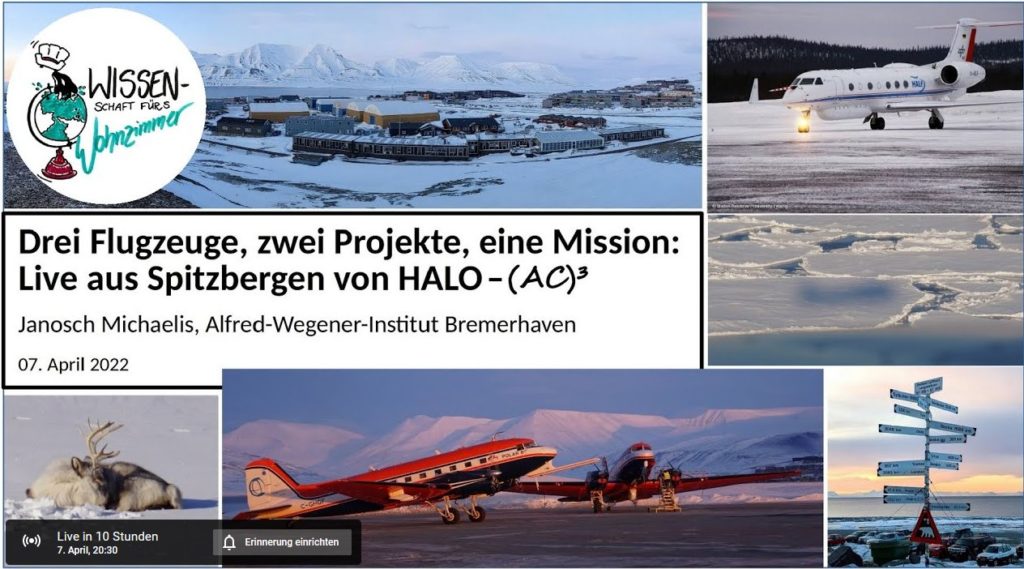
1 April 2022
Report in the @saechsischeDE on the #HALOAC3 measurement campaign and the warming of the Arctic. #AC3TR @UniLeipzig @TROPOS_eu @dfg_public https://t.co/LUj18OJ0nh
— HALO-(AC)³ (@HALOAC3) April 4, 2022
1 April 2022
Probing a Cold Air Outbreak
Our flight today probes a very intensive Cold Air Outbreak. This phenomenon describes cold air moving from the Arctic southwards and thus is the counterpart to a Warm Air Intrusion (see posting from 13 March 2022).
Susanne Crewell explains: “… cold air which is formed in the central Arctic is pushed out of the Arctic towards the south. Then, this very cold air flows above the relatively warm ocean and convective clouds are formed. These cold air masses with embedded showers often reach far into central Europe and bring for example the classical April graupel showers. Thus, transports of […] cold air masses have strong effects on the European weather. With the Arctic warming faster than the rest of the globe the question is how these “air mass” transports change in their frequency of occurrence and duration. Changes are likely as tempe[1]rature differences drive atmospheric motions. However, many details are not fully understood making our measurements highly interesting.”
Cold Air Outbreaks as well as Warm Air Intrusions are important drivers of the so-called Arctic Amplification. This phenomenon describes the much stronger warming of the Arctic compared to average Global Warming. The effects of this increase in temperature are not limited to the climate system in the Arctic, but do modify the regional weather in the mid-latitudes, as well.
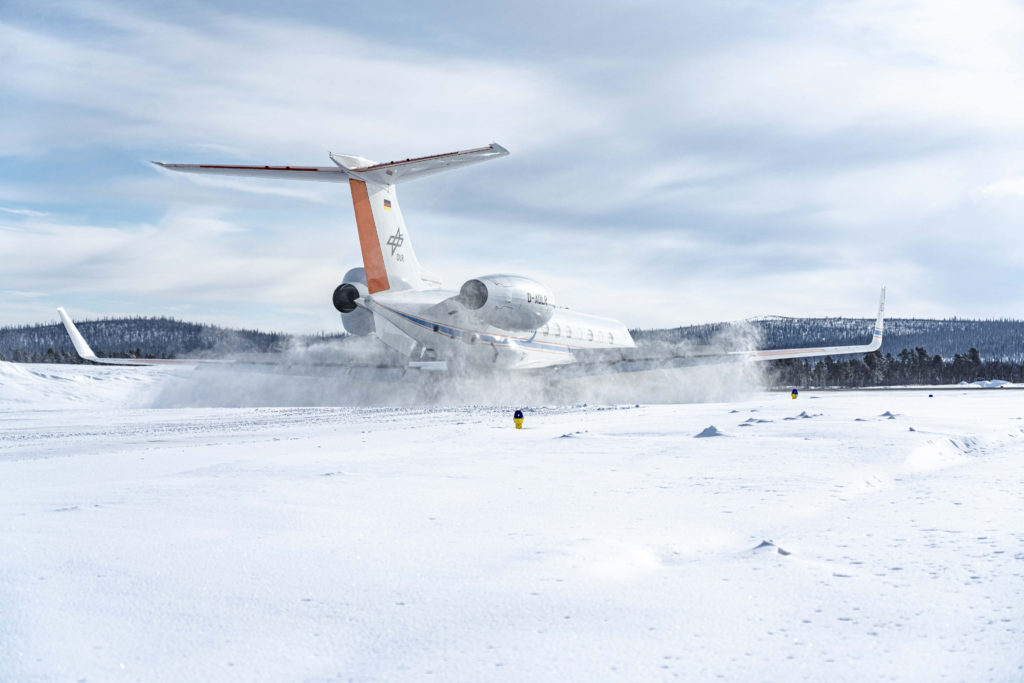

1 April 2022
Let’s talk about dropsondes again: We have an incredible plan for today’s flight. We are going to launch 43 dropsondes! Although not too many dropsondes are remaining for our campaign, it’s definitively worth it. We are going to perform the flight track displayed on the right. Thereby, each east-west-leg remains at a similar degree of latitude and leads over water as well as ice (except on the northernmost leg). This means that observed changes of the air mass are dominated by changes of the surface (ice vs. water). Performing several legs provides us with better statistics and thus gives us more certainty regarding the retrieved results. As each leg requires a bunch of dropsondes we end up with 43!
For accessing the impact of each component of the Arctic climate it is extremely important to disentangle relevant effects. Thus, we aim at a better understanding of Arctic Amplification and climate sensitivity.


30 March 2022
We got five aircrafts in the air!
One highlight of today’s flight was the coordination of five research aircraft for joint measurements. All of them contributed to an extremely valuable dataset. In the morning, HALO started from Kiruna. Subsequently, the British BAe-146, operated by FAAM, was on the move. Later, the Polar 6 and thereafter Polar 5 left from Svalbard. In the afternoon, the French ATR-42 from Safire started in order to catch HALO on its way back to Kiruna.
HALO flew circles with a diameter of 150 km at three different locations. Thereby, we threw ten dropsondes during each circle. These sondes get ejected from HALO, their attached parachute opens, and they glide to the ground. Thereby, they measure temperature, humidity, pressure and wind very precisely. By ejecting the dropsondes during a circular flight pattern, we can derive the vertical velocity of the air motion in the encircled area. This information is crucial for the investigation of cloud processes, e.g. the formation of clouds. We applied this approach for the first time in the Arctic and are really excited about the outcome. At the campaign EUREC4A, this technique was applied intensively and yielded very valuable results. These helped to understand the climate effects of clouds in the Tropics and the respective climate feedbacks in order to access Earth’s climate sensitivity.
The Polar 6 performed in-situ measurements in Circle 1 and 2 from HALO. Polar 5, which is equipped with similar remote-sensing instruments as HALO, probed the area of the second circle, also deploying dropsondes. Afterwards, HALO, Polar 5 and Polar 6 performed collocated flights. In the meantime, the British BA3-146 had a refueling stop in Longyearbyen, Svalbard. Thereafter, if performed a measurement flight leg together with HALO. Finally, on the way back, HALO met the ATR-42 for joint collocated measurements.
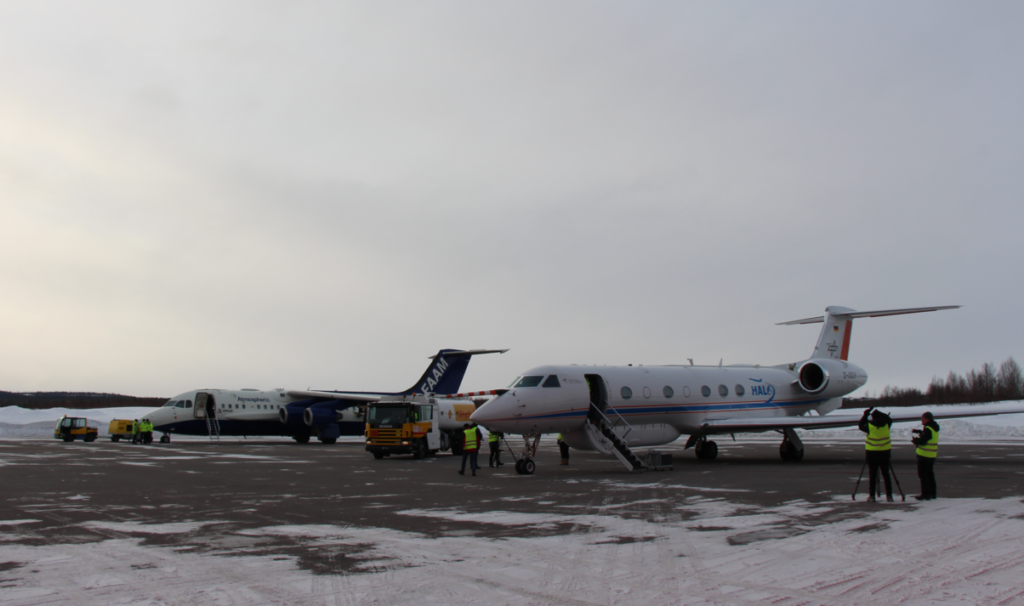


29 March 2022
Bericht im Tagesspiegel zur Messkampagne HALO-(AC)³ und die Erwärmung der Arktis und Antarktis:
https://www.tagesspiegel.de/wissen/aussergewoehnliche-erwaermung-warmfront-ueber-dem-nordpol/28207500.html
Warmfront über dem #Nordpol - @TspWissenschaft über @HALOAC3 > https://t.co/EOclrRd2WQ --- #HALOAC3 #AC3TR @dfg_public @UniLeipzig @AWI_de @DLR_de @TROPOS_de @MPI_Meteo @UniCologne @maxplanckpress … #Klima #Wetter
— TROPOS (@TROPOS_de) March 30, 2022
28 March 2022
Coordinated flight with three research aircraft
Today, we had another coordinated flight with HALO, Polar 5 and Polar 6. For the first time, the three research aircraft measured in close proximity, thereby covering three different altitude ranges. Why the multitude of three aircraft is extremely helpful for the campaign explains Susanne Crewell (University of Cologne):
“The German High Altitude Long Range Aircraft (HALO) is ideally suited to map the spatial structure of air masses from its base at Kiruna, Sweden. Flying far above 10 km, it employs various remote sensing instruments that provide information on cloud and precipitation properties and their effect on the atmospheric energy budget. It can cover more than 8000 km and by staying in the air for more than 8 hours it can observe the same “air mass” at different locations. In this way, the transformation of the air traveling into or out of the Arctic can be investigated.
While HALO provides the broad overview, the two Polar aircraft allow a detailed analysis of the air masses and which role the surfaces (sea ice, ocean) plays. Both aircraft have similar range, typically flying for about 4-5 hours out of Longyearbyen, Svalbard. Polar 5 can fly at around 3 km height with similar instrumentation as HALO, but is capable to resolve the structure of clouds much finer, including the very low clouds difficult to see from HALO. Polar 6 has so-called in situ instruments that give us information on the individual cloud particles including the different shapes of ice particles such as needles, columns or dendrites. Measurements include even more information such as on aerosol particles and turbulences.
By coordinating the flight patterns of the different aircraft we can zoom into the air masses from their development in space and time (HALO), into the finer details and surface influence (Polar 5) and even deeper into the ingredients of individual clouds (Polar 6). Finally, the combination of the different measurements allows us to arrive at a nearly complete picture.”


28 March 2022
Der Spiegel berichtet über unsere Messkampagne HALO-(AC)³ und die Erwärmung der Arktis:
https://www.spiegel.de/wissenschaft/natur/arktis-teils-20-grad-waermer-als-erwartet-a-c3816586-1459-4093-a1b3-839613caa516
Messflüge an der #Framstraße: #Arktis teils 20 Grad wärmer als erwartet - @derspiegel über @HALOAC3 > https://t.co/u2hRzv0Tk5 / #HALOAC3 #AC3TR @dfg_public @UniLeipzig @AWI_de @DLR_de @TROPOS_de @MPI_Meteo @UniCologne @maxplanckpress … #Klima #Wetter
— TROPOS (@TROPOS_de) March 30, 2022
26 March 2022
???Heute Nachmittag ab 16 Uhr starten wir einen Live-Audio-Talk aus der #Artkis von der @HALOAC3-Flugkampagne ❄️✈️ Mit dabei: @TerliWetter sowie die Wissenschaftler:innen Imke Schirmacher und Nina Maherndl. Ihr könnt dabei live eure Fragen stellen. ?https://t.co/KoV7Ai61zD
— AWI Medien (@AWI_de) March 26, 2022
25 March 2022
Özden Terli bei HALO-(AC)³ auf Spitzbergen 3sat Wissen NANO
23 March 2022
ZDF-Meteorologe Özden Terli bei HALO-(AC)³ auf Spitzbergen:
18 March 2022
Polar 5 and Polar 6 arrive in Longyearbyen, Svalbard
Today, the research aircraft Polar 5 and Polar 6 arrived at their operations base in Longyearbyen, Svalbard. With this, all airborne measurement platforms which are part of HALO-(AC)³ are ready for deployment. Besides the two polar aircraft, these are HALO, based in Kiruna (Sweden), and a tethered balloon near Ny-Ålesund on Svalbard. Furthermore, ground-based measurements will contribute to the multitude of datasets of HALO-(AC)³.

15 March 2022
We contributed to an article recently published in @washingtonpost including some first insights into the unusal warming event in the #Arctic causing those extreme high temperatures. In the right place at the right time #HALOAC3 #AC3TR https://t.co/RLjqZaTCaG
— HALO-(AC)³ (@HALOAC3) March 16, 2022
13 March 2022
First measurement flights completed: Astonishing observations
Right at the beginning of our campaign we met a weather situation perfectly suited for our investigations. Warm air masses moved north towards the Arctic, an event called warm air intrusion (WAIs). Hence, we set of for several flights over the Norwegian and the Greenland Sea as well as the Fram Strait to the North Pole.
We were astonished that the probed WAI was so strong. Surface temperatures in the Fram Strait were more than 20 degrees Celsius higher during than expected from the long-term records. Not just the intensity of the WAI is extraordinary but also its duration.
The WAI entailed heavy rain over sea ice, which favors an earlier melting of the sea ice and thus a decrease in sea ice cover. Furthermore, massive clouds have been observed, reaching almost as high as in the tropics.
11 March 2022
HALO arrives in Kiruna
Today, HALO arrived in Kiruna. The initial departure from Oberpfaffenhofen was delayed by a couple of hours because a bomb from World War 2 was found during excavation works. No further obstacles appeared.
We took a direct route to Kiruna in order to safe time, because already tomorrow and the day after tomorrow we will have our first two measurement flights from Kiruna. Warm air masses move northwards into the Arctic, which we aim at.

25 February 2022
Scientific Test Flight successsfully completed
Today the work began early – already at 5:30 people were busy in the HALO hangar in order to prepare our scientific test flight. Around 8:30 the preparations were concluded and HALO took off. We passed Leipzig and Lindenberg, where ground-based measurements were performed, which can be used for scientific comparisons. After passing the Baltic Sea, HALO headed for the North Sea. Here, an airspace was reserved for us, so that we could perform a number of maneuvers in order to calibrate various instruments. Afterwards, we flew back home On the way, we passed Cologne, where further comparative ground-based measurements were performed.
No major problems occured, everything worked out well. Now, we feel well prepared and are eagerly awaiting the start of the campaign in about two weeks time.
21 February 2022
First take off for HALO-(AC)³: EMI Flight



